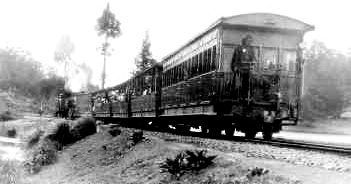 |
| The line, granted World Heritage status, has still not lost its charm. | ||
The happy news that the Nilgiri Mountain Railway (NMR) line has been granted World Heritage Status by UNESCO is bound to warm the cockles of heritage lovers. So, now is the time to take that joy ride you have always wanted to but kept postponing for one reason or the other. Is the train ride still so exhilarating? This writer who made the
trip recently, four decades after the compulsory excursion trip while
at school, would happily vouch for it. Whatever be the changes that
may have befallen the Nilgiri hills over the last half a century, the
corridor through which the NMR meanders up the mountain seems to have
been untouched and retains much of the old Nilgiris' charm.
Tall thickets of bamboo, dark and damp rain forests playing hide and seek with the glittering rays of the sun, frighteningly hanging rocks, deep ravines, grand aerial views of the low lands as the train ascends, imposing massifs overhead, panoramic view of tea gardens, majestic eucalyptus groves, quaint views of Badaga villages, way stations wearing period looks... they are all almost intact. So much so, despite the narrow, cramped seat, it was like sitting through a long but thrilling movie. With some comforts added following the new-found status, the journey could be more joyful. There are only about 30 of these vintage cog railways left in the world. What is unique about rail relics is the toothed extra rail running in the middle of the normal rails, which holds the train from sliding on the slopes. The Alternate Biting Tooth (Abt) system which operates on most mountain railways in the world, also works for the Ooty train. Interestingly, the name of the man who invented this system was also Michael Abt. The NMR is one of its kind and the steepest mountain railway in Asia with an average gradient of 1 in 12.5. That is, on an average for every 12.5 feet the train travels the height or altitude rises by one foot. Normally gradients in the railways are only of the order of 1 in 200 or 1 in 1,000. Even mountain railways are ordinarily comfortable with grades no steeper than 1 in 40. Only traction rail systems like the cog railways operate on grades as steep as 1 in 12. The Nilgiri Passenger, as the NMR is called, began its journey in 1899 after decades of pioneering challenges and several financial disasters. It goes to the credit of these pioneers that in its more than a hundred years of operation, there has been just one accident, which happened in 1982. Several names are intimately associated with this wonder railway, of which one deserves to be remembered most. Major Morant of the Royal Engineers, who was the district engineer in the Nilgiris, when the proposal for the railway was mooted, was the moving spirit behind the venture. He wrote several articles including `Mountain Railways for the Nilgiri Hills' in technical journals in the 1870s, making out a case for the mountain train, which finally became a reality in the 1890s. Visitors today may be amused at the slow pace (13 kmph on the rack rails) of the train and may even be tempted to trot alongside it. But in the days before NMR, travellers to the hills, especially the memsahibs were hard to put to make the back-breaking journey by horse, (if you were `young and vigorous'), by bullock carts or carried in a palanquin (if you were `older or young and lazy'). The bullock carts averaged four and half to five miles an hour while the horses did five to six. One can imagine how comfortable would have been the journey by bullock cart by the following account. "... The bullock cart traveller's luggage was put in the wagon, boards were laid across the valises and bedding was placed on top. Reclining regally thereon, he was towed away with stops for refreshment and rest at the dak bungalows. Or he could refresh himself having taken the precaution of seeing to it that sides of the bullock cart were fitted with pockets of coarse cloth into which could be stowed the wine, the beer, the brandy and the kettle... ". The NMR surely must be one of the most photographed railways in the country, besides being featured in movies and advertisements. The familiar blue and yellow train has played intimate roles in several movies such as "Aradhana", "Moonram Pirai" and "Dil Se".Hollywood's David Lean featured the train in his "Passage to India" after giving it a period look. An advantage that the Nilgiris shared with Madras in late 19th Century was that most of the early photographers who put up shop in Madras also had their studios on the hills — A.T.W. Penn, Boesinger and Willie Burke, to name a few. For them the hill train presented a photo opportunity next only to the exotic tribes on the hills. Some of these rare photographs have survived. |